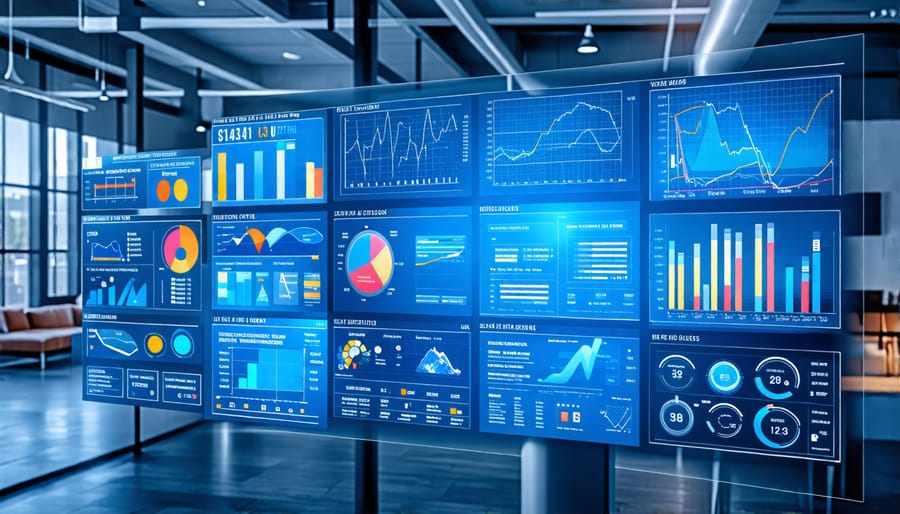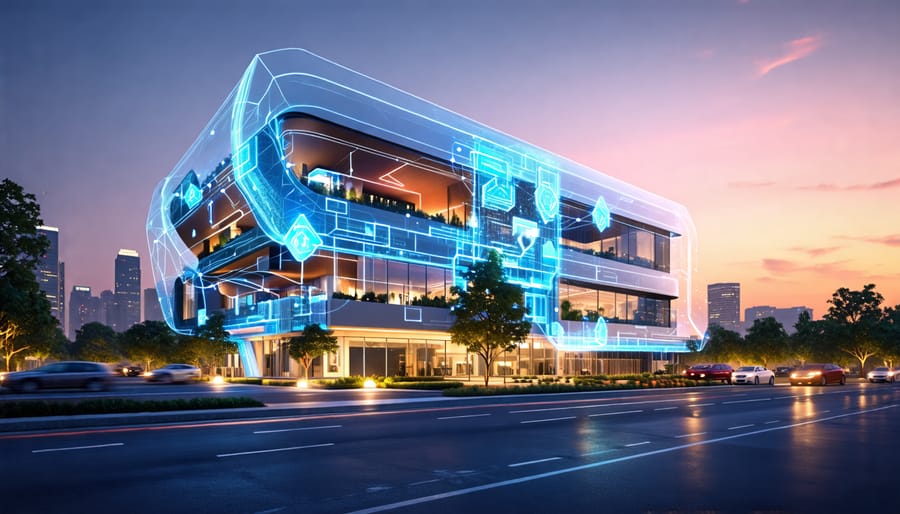Discover the game-changing world of smart buildings – interconnected structures that leverage cutting-edge technology to optimize operations, enhance sustainability, and revolutionize how we live and work. Powered by the Internet of Things (IoT), artificial intelligence, and advanced sensors, smart buildings are ushering in a new era of efficiency, comfort, and adaptability. From reducing energy consumption to improving occupant well-being, these intelligent structures offer a myriad of benefits that are transforming the construction industry. Join us as we explore the key features, real-world examples, and future outlook of smart buildings, and uncover how they are reshaping our built environment for the better.

Key Features of Smart Buildings
Integrated Building Management Systems
Integrated Building Management Systems (IBMS) are the backbone of smart buildings, enabling centralized control and optimization of various building functions. These advanced systems leverage sensors, automation, and data analytics to streamline operations, enhance energy efficiency, and improve occupant comfort. IBMS interconnect and monitor critical building systems, such as HVAC, lighting, security, and fire safety, allowing for real-time adjustments and proactive maintenance. By integrating these systems, building managers can identify inefficiencies, reduce energy consumption, and make informed decisions based on comprehensive data insights. The centralized control provided by IBMS not only simplifies building management but also enables remote monitoring and control, ensuring optimal performance even when personnel are off-site. As the demand for sustainable and efficient buildings grows, the adoption of IBMS has become a critical factor in achieving smart building objectives and driving operational excellence in the construction industry.

Advanced Sensor Networks
Advanced sensor networks form the backbone of smart buildings, enabling real-time monitoring and adjustment of various environmental conditions. These sensors continuously collect data on temperature, humidity, lighting levels, air quality, and occupancy. The data is then analyzed by the building management system (BMS) to optimize conditions for occupant comfort and energy efficiency.
For example, smart thermostats with integrated sensors can detect when rooms are occupied and adjust the temperature accordingly, reducing energy waste in unused spaces. Similarly, smart lighting systems use occupancy and daylight sensors to automatically adjust lighting levels based on need, improving both comfort and energy savings. Air quality sensors monitor CO2 levels, volatile organic compounds (VOCs), and particulate matter, triggering ventilation systems to maintain a healthy indoor environment.
By leveraging advanced sensor networks, smart buildings create a responsive, efficient, and comfortable environment that adapts to the needs of occupants while minimizing energy consumption and operational costs.
Intelligent Energy Management
Smart buildings employ advanced energy management systems to optimize energy usage and reduce costs. These systems continuously monitor and analyze energy consumption data, identifying opportunities for efficiency improvements. Through intelligent algorithms and machine learning, smart buildings can automatically adjust lighting, heating, cooling, and ventilation based on occupancy levels, weather conditions, and time of day. This dynamic response ensures energy is used only when and where it’s needed. Smart buildings also integrate renewable energy sources like solar panels and energy storage systems to further minimize reliance on the grid during peak demand periods, resulting in significant cost savings and reduced environmental impact.
Benefits of Smart Buildings
Enhanced Energy Efficiency
Smart buildings leverage advanced technologies and integrated systems to drastically reduce energy consumption and operating costs. By continuously monitoring and optimizing energy usage, smart buildings can achieve significant savings compared to traditional structures. Intelligent HVAC systems, smart lighting, and advanced sensors work together to maintain optimal conditions while minimizing waste. Real-time data analytics allow building managers to identify inefficiencies and make data-driven decisions to further enhance energy performance. Smart buildings also often incorporate renewable energy sources, such as solar panels or wind turbines, to generate clean power on-site. These energy-saving features not only lead to lower utility bills but also contribute to a more sustainable future. As technology continues to evolve, the potential for energy-efficient homes and commercial buildings grows, making smart buildings an increasingly attractive investment for forward-thinking property owners and developers.
Improved Occupant Comfort and Productivity
Smart buildings use advanced technologies to create optimal working and living environments that enhance occupant comfort and productivity. By integrating sensors, intelligent lighting systems, and connected HVAC controls, smart buildings can automatically adjust temperature, humidity, and illumination levels to suit occupants’ preferences and the task at hand. For example, the lighting can automatically dim or brighten based on the amount of natural light entering the space, reducing eye strain and improving visual comfort. Smart buildings also prioritize indoor air quality by continuously monitoring and adjusting ventilation to maintain a healthy, fresh atmosphere. This promotes better cognitive function and reduces the risk of health issues like headaches and fatigue. Additionally, smart building features such as noise-cancelling technologies, personalized thermal zones, and adaptable workspaces contribute to a more pleasant and productive environment. By leveraging data analytics and occupant feedback, facility managers can make informed decisions to optimize comfort settings and respond to changing needs. The result is a building that actively works to support the well-being and efficiency of its occupants, ultimately leading to increased satisfaction, creativity, and overall productivity.
Reduced Environmental Impact
Smart buildings significantly reduce environmental impact through decreased energy consumption and the use of sustainable materials. By leveraging advanced technologies like IoT sensors, AI-driven energy management systems, and renewable energy sources, these buildings optimize energy usage and minimize waste. Smart HVAC systems, automated lighting controls, and predictive maintenance algorithms work together to create an energy-efficient environment. Moreover, the incorporation of green building materials, such as recycled steel, low-VOC paints, and locally sourced timber, further reduces the carbon footprint associated with construction and operation. These eco-friendly features not only benefit the planet but also contribute to a healthier indoor environment for occupants. As the construction industry continues to prioritize sustainability, smart buildings stand at the forefront of this green revolution, setting a new standard for environmentally responsible development.
Real-World Examples
One impressive example of a successful smart building project is The Edge in Amsterdam, considered one of the world’s smartest and most sustainable office buildings. This 40,000 square meter structure boasts a host of intelligent features, including 28,000 sensors that monitor everything from occupancy to energy usage. The building’s smart lighting system automatically adjusts based on daylight and occupancy, while its innovative aquifer thermal energy storage system provides efficient heating and cooling. These features have helped The Edge achieve a BREEAM rating of “Outstanding,” the highest sustainability rating possible.
Another notable case study is the Starbucks’ energy-efficient modular store in Northgate, Seattle. This 450 square foot drive-thru cafe was built using modular construction techniques and incorporates a variety of smart and sustainable features. The store is powered by an integrated solar panel system and uses efficient LED lighting and water-saving plumbing fixtures. Real-time monitoring of energy consumption allows for ongoing optimization of the store’s performance. This innovative project demonstrates how smart building principles can be applied to smaller-scale, modular construction projects with impressive results.
These real-world examples showcase the potential of smart buildings to drive significant improvements in energy efficiency, sustainability, and occupant comfort. As more projects embrace intelligent building technologies, we can expect to see even more impressive case studies emerge, setting new standards for what is possible in the built environment.
The Future of Smart Buildings
As smart building technology continues to advance, experts predict a future where these structures not only optimize energy efficiency and occupant comfort but also seamlessly integrate with urban sustainability initiatives. The rise of AI, IoT, and 5G will enable smart buildings to adapt in real-time, learning from occupant behavior and external factors to continuously improve performance. However, challenges such as data privacy, cybersecurity risks, and the need for standardized protocols must be addressed. Opportunities lie in the development of more intuitive, user-friendly interfaces and the potential for smart buildings to contribute to the creation of resilient, eco-friendly cities. As the construction industry embraces digital transformation, collaboration between stakeholders will be crucial in shaping the future of smart buildings. By harnessing the power of emerging technologies and fostering innovation, the sector can pave the way for a more sustainable, efficient, and connected built environment.

